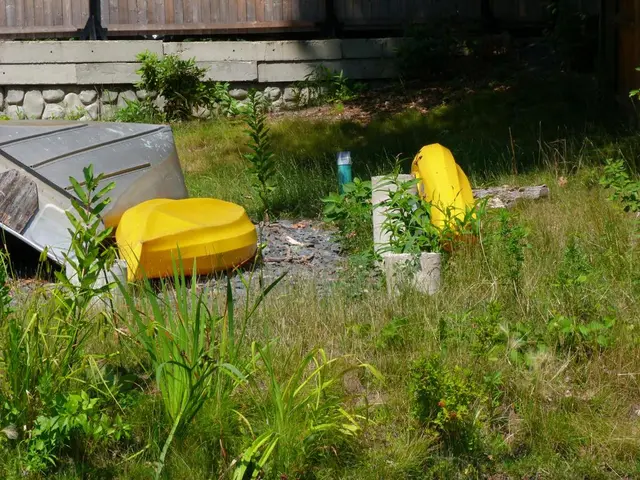Qatar and Chevron to collaborate on a $6 billion gas-to-plastics manufacturing facility construction project
QatarEnergy and Chevron Phillips Announce Major Petrochemicals Investment
In a significant move for Qatar's petrochemicals sector, QatarEnergy and Chevron Phillips Chemical have joined forces to create the Ras Laffan Petrochemicals Complex. Located approximately 80 kilometers north of Doha, this $6 billion joint venture represents QatarEnergy's largest investment in the petrochemical sector to date [1][3].
Production Capacity
At the heart of the complex is an ethylene cracker with an annual capacity of 2.1 million tonnes, making it the largest ethylene cracker in the Middle East and one of the biggest globally [1]. The facility also includes two polyethylene trains, producing a combined 1.7 million tonnes of High-Density Polyethylene (HDPE) annually. This expansion will increase Qatar’s overall petrochemical production capacity by about 50%, driving its total annual output to roughly 14 million tonnes by the end of 2026 [1][3].
Economic and Strategic Impact
This project is a "landmark" in QatarEnergy’s downstream expansion plan and strengthens Qatar's position as a key global player in energy and petrochemicals, expected to generate significant economic benefits for the country [1]. The ethylene capacity increase alone exceeds 40% of Qatar's existing ethylene production, enhancing the country's integrated petrochemical value chain [1].
Emissions and Environmental Impact
While specific emissions data or environmental impact assessments for the Ras Laffan Petrochemicals Complex were not detailed in the available sources, as a large-scale petrochemical facility with ethylene crackers and polyethylene production, general emissions would involve CO2, VOCs, and other typical petrochemical process emissions. However, QatarEnergy, as a state and globally aware enterprise, likely incorporates mitigation technologies, though this is not explicitly stated.
Relation to Qatar’s Wider Petrochemical Sector
The project is a core part of Qatar’s ambition to expand its petrochemical footprint integrated with its vast natural gas resources from the North Field. Ras Laffan Industrial City is a hub for LNG and petrochemical production, including expansions in LNG capacity tied to the North Field projects [2][3]. The facility complements ongoing LNG expansions and other chemical projects, reinforcing Qatar’s strategy to diversify hydrocarbon exports by not only exporting gas but also value-added chemical products [3].
The Ras Laffan Petrochemicals Complex is scheduled to begin running in 2026. This investment underscores Qatar's commitment to strengthening its position as a major global player in the upstream, LNG, and downstream sectors, with ethylene and polyethylene being used in a wide range of plastic products.
References:
[1] QatarEnergy. (2022). QatarEnergy and Chevron Phillips Chemical announce joint venture for petrochemicals complex in Ras Laffan. Retrieved from https://www.qatarenergy.com/en/news/qatar-energy-and-chevron-phillips-chemical-announce-joint-venture-for-petrochemicals-complex-in-ras-laffan
[2] Reuters. (2022). QatarEnergy and Chevron Phillips to build $6 billion petrochemical complex. Retrieved from https://www.reuters.com/business/energy/qatarenergy-chevron-phillips-to-build-6-billion-petrochemical-complex-2022-03-23/
[3] Al Jazeera. (2022). Qatar to build $6bn petrochemicals complex with Chevron Phillips. Retrieved from https://www.aljazeera.com/economy/2022/3/23/qatar-to-build-6bn-petrochemicals-complex-with-chevron-phillips
Financial investments in Qatar's petrochemicals industry are on the rise, with energy companies like QatarEnergy and Chevron Phillips making significant contributions, such as the upcoming $6 billion Ras Laffan Petrochemicals Complex. This investment in the energy sector will not only increase Qatar's production capacity for ethylene and polyethylene but also foster the growth of the related finance sector, as these petrochemical products are used in a wide range of industries worldwide.




